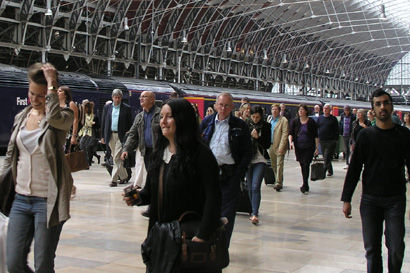NEW FIGURES from the Office of Rail Regulation suggest that overcrowding on peak time trains may be rising again, following the dip caused by the economic crisis in 2009.
The most overcrowded trains are on First Great Western, where one early morning train from Worcester to Paddington with an official capacity of 381 passengers in standard class was actually carrying 635 by the time it was approaching London, giving a 'Passengers in Excess of Capacity' (or PiXC) measure of 167 per cent.
This train, the 05.02 from Worcester Shrub Hill, heads a list of the 'ten most overcrowded trains', according to figures released alongside the ORR report by the Department for Transport.
Number two on the list was a FGW intercity train from Swansea, with a PiXC of 160 per cent, while the third was also a FGW train, this time from Oxford, with a PiXC of 154 per cent.
The 'top ten' list includes six First Great Western trains, two on the Thameslink route of First Capital Connect and one each from Southern and National Express East Anglia.
Outside London the evening peak is sharper, with more passengers carried than in the morning, which is the reverse of what happens in London.
Birmingham had the highest demand, with 36,100 passengers in the evening peak on a typical weekday in autumn 2010. This was followed by Manchester (29,400 departures) and Leeds (23,800).
The highest percentage of standard class passengers standing outside the south east was recorded at Leeds, with 14 per cent standing in the morning and 12.1 per cent in the evening.
Both the ORR and the DfT warn that their figures, which were gathered in the autumn of 2010, should be treated with 'caution', because methods of measurement vary among operators and some have been estimated.
The DfT also says that more recent counts reveal that the level of overcrowding has eased this year on some of the 'top ten' trains, but publication of these figures follows the recent revelation by ATOC that passenger figures rose generally in the first half of this year by six per cent, taking the number of journeys made on National Rail back to levels not seen in peacetime since the 1920s.
ATOC responded to the latest statistics by blaming the Department for Transport for 'too much' involvement in railway management.
A spokesman said: "We understand passengers’ frustration when they can’t get a seat. Train companies now run 20 per cent more services a day than at the start of privatisation but there are limitations to what they can do. In recent years, too much involvement by civil servants has too often held up the delivery of new carriages and limited operators’ ability to plan for and respond to overcrowding.
"It’s good news that the coalition government is investing in over 2,500 new carriages and has pledged to introduce more flexible franchises that will allow operators to respond better to overcrowding. Train companies will work with the Government to ensure additional carriages are delivered."


